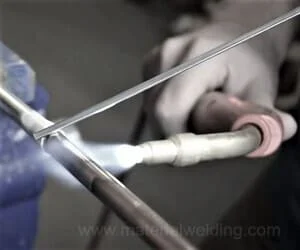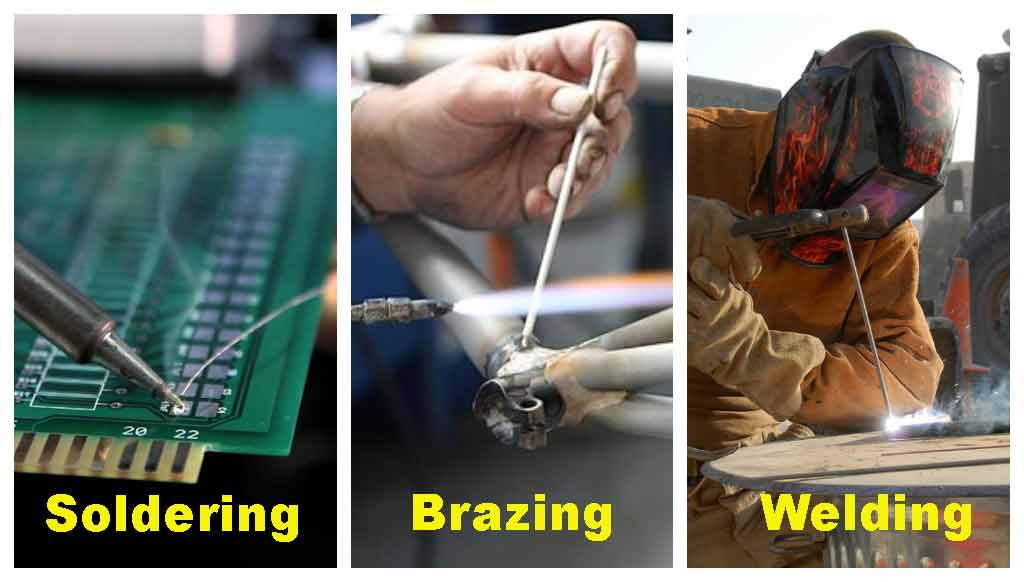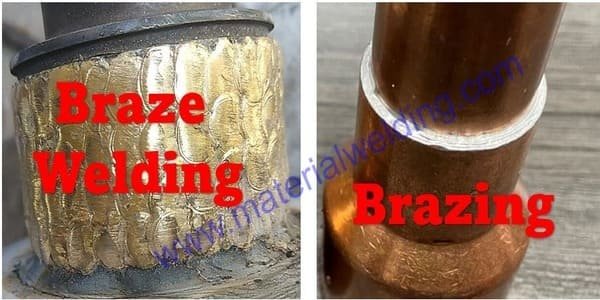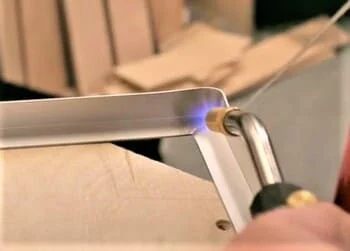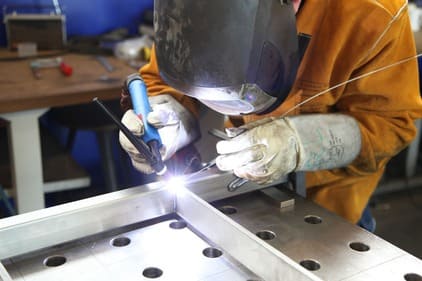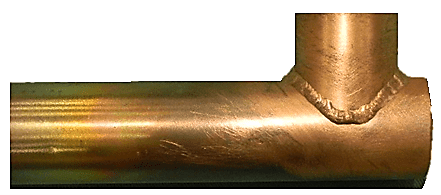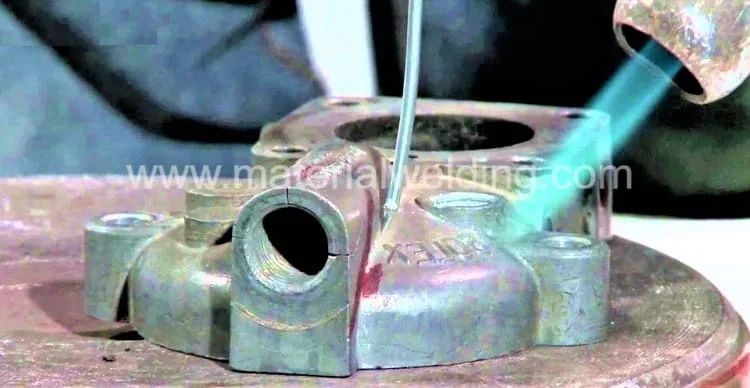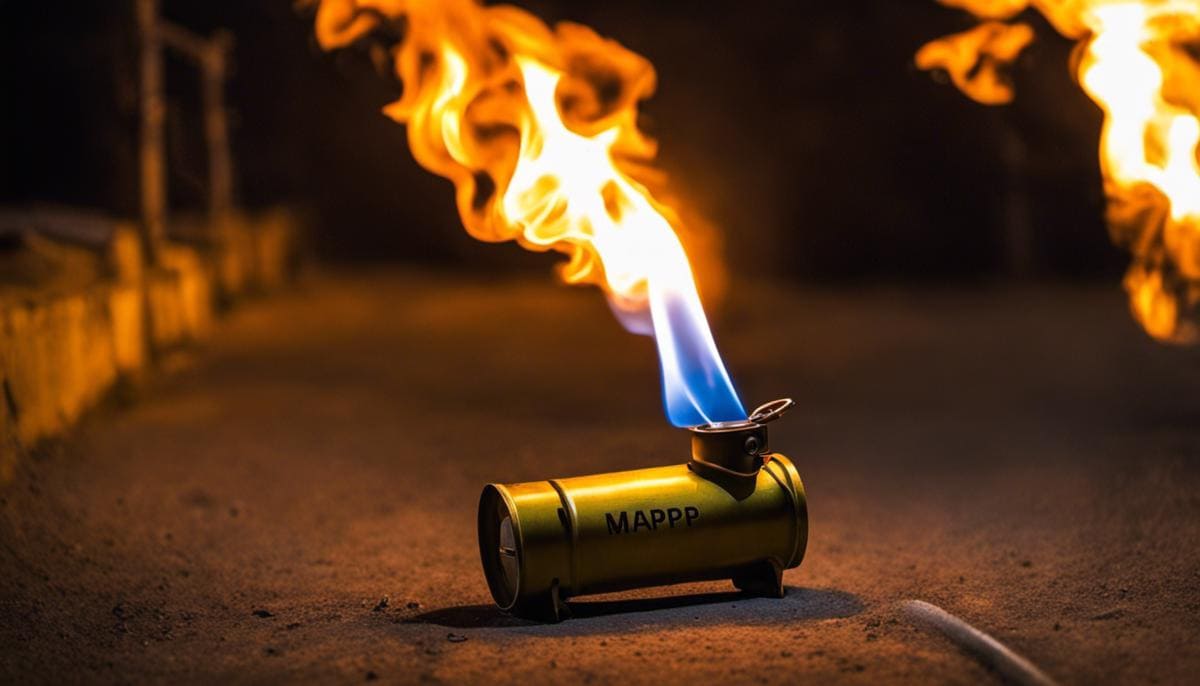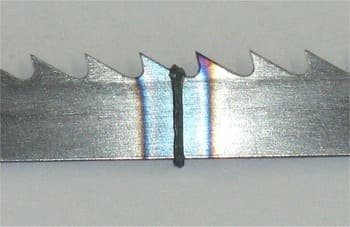The question often arises as to whether the process of soldering or brazing should be used for brazing copper.
Basically, copper can be brazed very well using Brazing & Soldering.
Brazing copper is a commonly used soldering method in many fields, such as plumbing, electrical work, and even jewelry making.
It is a great way to join two pieces of copper together without melting them or using a flux.
Consideration for Copper Brazing
Decisive for the soldering process is the proportion of oxygen in the copper, as this determines the brittleness.
This is due to hydrogen bonds. At higher temperatures, the hydrogen reacts with oxygen to form water and so-called hydrogen embrittlement occurs.
These embrittlement’s cause cracks and hollow spaces and usually occur during brazing (flame brazing and brazing with reduced shielding gases).
Thermally and mechanically highly stressed components with low oxygen content are usually brazed.
For brazing copper, a silver solder, a copper-phosphor solder or a brass solder is usually used. In soft soldering, on the other hand, tin-containing solders are used and, in special cases, toxic lead solders.
Related Posts: How to Braze Aluminum
Copper Brazing or Soldering?
The soldering of copper tubes is basically to be distinguished between brazing and soft soldering.
As a rule, heating or drinking water pipes are soldered softly as copper tubes. Whether do-it-yourselfers or professionals want to solder the copper tube, there is a lot to consider.
Whether you want to solder copper pipes, seal a gutter or tinker with electronic components: All this can be learned quickly with the right instructions for soldering.
Copper Tube or Pipe Brazing
Both methods of copper tube soldering require the addition of heat (blowtorch, soldering iron, etc.).
For soft soldering you need soft solder (e.g., copper 3% and tin 97%) with melting temperatures up to 250 degrees Celsius.
Brazing brazing also contains brass, phosphor and silver. Brazing melts at temperatures above 450 degrees (usually up to 600 to 700 degrees Celsius).
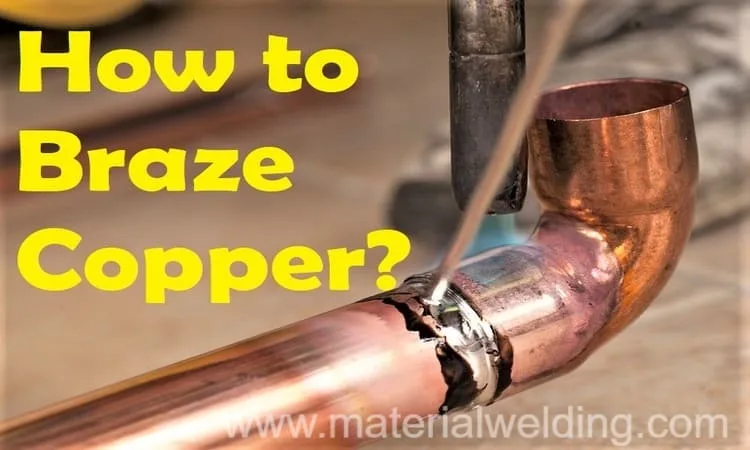
Both soldering methods also require flux or solder paste. Flux additionally cleans the solder joint and ensures good wetting of the part to be soldered with the solder. Both soldering methods require some experience.
As heating devices, electric soldering iron (soft only) or a blowtorch (gas burner/butane, propane) are required for brazing and soft soldering. Hard-soldered areas are more resilient than softly soldered ones.
In each case, the tubes to be connected must be well cleaned before brazing as well as before soft soldering. In order for the solder to attach to the metal surface, it must be completely free of grease and dirt.
The preparation of the copper tube for copper tube soldering is also the same in both soldering processes.
The copper tubes to be soldered must each be cut to the desired length. To do this, clamp in vice and cut off at right angles with a fine metal saw.
Then carefully deburr to avoid swirling in the pipe during use. This could eventually lead to copper pipe pitting (corrosion result).
Calibrating the pipe ends to be soldered with a calibration mandrel compensates for deformations caused by shortening the tube. This ensures the function of the capillary effect (gradeability in pipe gap/surface tension) during soldering.
What is Soldering?
Technically speaking, soldering is a thermal process for bonding materials. In other words, two metal workpieces are joined together by bringing them into contact with another heat-melted metal, the solder.
After cooling and solidification of the solder again, a firm connection is formed.
Soldering is a metal joining process that uses a lower melting point metal alloy, called solder, to join two or more metal parts together.
In soldering, the parts to be joined are heated with a soldering iron, torch or other heat source, and the molten solder is applied to the joint where it cools and solidifies to form a strong bond.
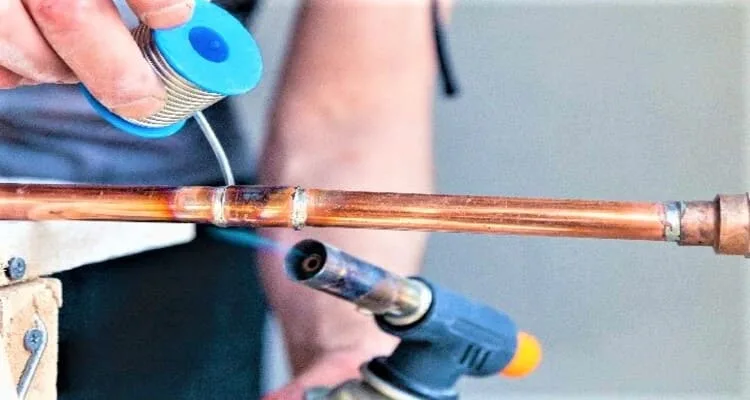
Soldering is often used in electronics, plumbing, and other applications where a low-temperature method of joining metal parts is needed.
The solder used in the process typically consists of a mixture of metals such as tin, lead, or silver, although lead-free solders are becoming more common due to health and environmental concerns.
One of the benefits of soldering is that it allows for precise and clean connections, making it well-suited for delicate electronic components.
What is Brazing?
Brazing is a metal joining process that uses heat and a filler metal to join two or more metal parts together.
Unlike welding, brazing does not melt the base metals, but instead the filler metal is melted and flowed into the joint between the two parts, where it solidifies to create a strong bond. The filler metal used in brazing has a melting point that is lower than the base metals.
Brazing is commonly used to join metals such as steel, stainless steel, brass, and copper. It is often used in the production of refrigeration and air conditioning systems, jewelry, and other products that require strong, leak-proof joints.
Brazing can also be used to repair cracks or holes in metal parts, and to join dissimilar metals a well as cast iron welding.
One of the advantages of brazing is that it allows for the joining of parts without significantly affecting the properties of the base metal.
This makes brazing a suitable method for joining parts that will be subjected to high stress or temperature, as it allows the base metal to retain its strength and toughness.
Tools Required for Copper Brazing?
You don’t need a lot of tools and materials. The following list gives an overview of what is needed for soft soldering of copper tubes:
- Gas burner or blowtorch
- Cleaning fleece
- Fitting lot
- Solder paste
- Brush or cotton swab for applying the solder paste
- Screw clamp or vice to hold the parts during soldering
The gas burner or blowtorch is used to heat the solder joint. Alternatively, a burner from the kitchen can be used.
Related post: How to Braze Aluminum to Copper
How to Braze Copper: Steps for Copper Brazing
Copper brazing typically involves the following steps:
Clean the surfaces to be joined
Before brazing, it is important to thoroughly clean the surfaces of the parts to be joined to remove any dirt, grease, or other contaminants that could affect the quality of the joint.
This can be done using a wire brush, sandpaper, or a chemical cleaner.
Assemble the parts
Once the surfaces are clean and dry, the parts to be joined should be carefully positioned and secured in place. This can be done using clamps, jigs, or other holding devices.
Apply the brazing filler metal
Next, the brazing filler metal is placed in the joint between the two parts. The filler metal can be in the form of wire, foil, or preformed rings, depending on the application.
Heat the joint
The joint is then heated using a torch, furnace, or other heat source. The temperature required will depend on the specific filler metal being used and the thickness of the parts being joined.
As the joint heats up, the filler metal melts and flows into the joint, creating a strong, permanent bond.
Allow to cool
Once the brazing is complete, the joint should be allowed to cool slowly to avoid any thermal shock that could cause cracking or other damage.
The joint can be protected from oxidation during cooling by covering it with a blanket of dry sand or another suitable material.
Clean the joint
Finally, the joint should be cleaned to remove any flux residue or other debris that may have accumulated during the brazing process. This can be done using a wire brush, sandpaper, or a chemical cleaner.
Related Post: Copper Welding
Steps for Copper Soldering
1. Roughening the solder joint
In order for the solder to adhere well to the parts to be soldered, roughening of the surfaces to which the solder is to adhere is necessary.
To do this, rub the fleece around the end of the tube with sufficient pressure. The inside of the fitting is also roughened.
2. Applying the solder paste
Next, apply some solder paste to the inside of the fitting with a brush or cotton swab. Now the pipe and fitting can be plugged together.
3. Heat and apply solder
Now clamp the copper tube into a vice or fix it with the help of a screw clamp or clamping pliers so that the solder joint can be heated.
If the solder joint is hot enough, the solder must be held to the small gap between the tube and fitting with further heat supply.
The solder melts and creeps into the gap due to the capillary effect. After cooling, the solder connection is ready.
Copper Pipe Soldering Technique
If you want to connect copper pipes directly to each other or to fittings, soft soldering is usually suitable for heating and sanitation.
To do this, plug together the two pipe parts to be connected according to the pretreatment described above.
Then apply flux or solder paste at the solder joint to the outside of the copper tube. Now adjust the flame of the blowtorch according to the pipe thickness (flame glows blue).
Point the flame selectively at the solder joint. If the flux changes to silver, the soldering temperature fits.
Now remove the flame and move the solder in a semicircle at the solder joint (connection of the two pipe parts).
The capillary effect pulls the solder into the fine space (solder gap) of the joined pipe parts.
If a drop forms at the bottom of the solder joint (molten tin), the soldering process is finished. Carefully wipe off the remains of flux (still hot). Until cooling, fix the tube! Finally, check leaks.
Do you need flux to braze copper?
Yes, flux is typically required when brazing copper to help ensure a successful joint. Flux is a chemical compound that is used to clean the surfaces of the parts being brazed and to prevent oxidation during the brazing process.
Without flux, the surface of the copper parts can become contaminated with oxides, which can inhibit the flow of the brazing filler metal and result in a weak joint.
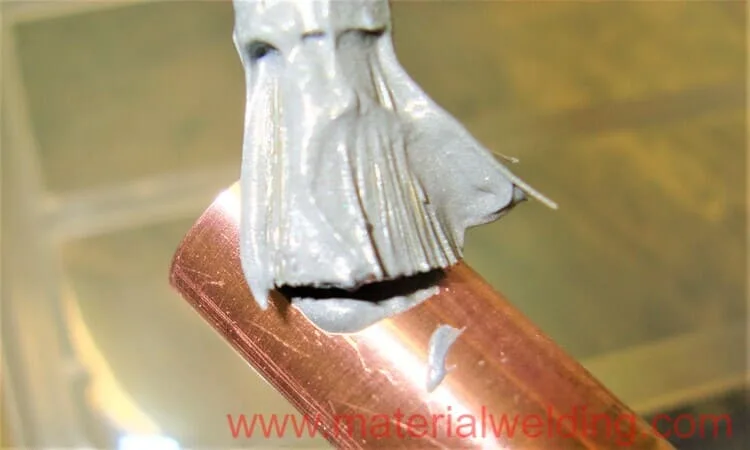
The type of flux used in copper brazing can vary depending on the application, but common types include borax-based fluxes and silver-based fluxes.
Borax-based fluxes are less expensive and are suitable for most copper brazing applications, while silver-based fluxes are more expensive but may be required for certain high-temperature or high-stress applications.
The flux is typically applied to the joint before the brazing filler metal is added, and it is important to use the appropriate amount of flux to ensure good coverage of the joint.
After brazing, any remaining flux residue should be cleaned from the joint to prevent corrosion or other issues.
Best Copper Brazing Filler Rods
- Harris Stay-Silv 15: This silver-based brazing filler metal is widely used for brazing copper and copper alloys. It has a melting temperature of 1190°F (643°C) and provides good strength and corrosion resistance.
- Lucas-Milhaupt Handy One: This silver-based brazing filler metal is designed for easy handling and is often used for HVAC and plumbing applications. It has a melting temperature of 1205°F (651°C) and provides good strength and ductility.
- Lucas-Milhaupt Sil-Fos 15: This phosphorus-copper brazing filler metal is designed for use with copper and copper alloys, and provides good strength and corrosion resistance. It has a melting temperature of 1460°F (793°C).
- Bernzomatic WB5 Bronze Flux Coated Brazing Rods: These bronze brazing filler rods are often used for joining copper to steel or cast iron, and provide good strength and corrosion resistance. They have a melting temperature of 1680°F (916°C) and are pre-coated with flux for easy use.
Types of Copper Brazing Rods
There are several types of filler metals that can be used for copper brazing, and the choice of filler metal will depend on the specific application and the properties required of the joint.
Some common types of filler metals for copper brazing include:
- Silver-based alloys: Silver brazing alloys are often used for high-temperature applications or for joints that require high strength and ductility. These alloys typically have a melting temperature between 1145°F and 1650°F (618°C and 899°C) and can be used to join copper to itself or to other metals such as stainless steel or nickel alloys.
- Phosphorus-copper alloys: Phosphorus-copper brazing alloys are often used for lower-temperature applications and can be used to join copper to itself or to other metals such as brass or bronze. These alloys typically have a melting temperature between 1190°F and 1475°F (643°C and 802°C) and are known for their ability to flow well and create strong, leak-tight joints.
- Silicon-bronze alloys: Silicon-bronze brazing alloys are often used for joining copper to itself or to other metals such as steel or cast iron. These alloys typically have a melting temperature between 1850°F and 1960°F (1010°C and 1070°C) and are known for their high strength and good corrosion resistance.
- Aluminum-silicon alloys: Aluminum-silicon brazing alloys are often used for joining copper to aluminum or aluminum alloys. These alloys typically have a melting temperature between 1070°F and 1200°F (577°C and 649°C) and are known for their ability to create strong, ductile joints.
Can I braze copper with a propane torch?
Yes, you can braze copper with a propane torch. Propane torches are commonly used for brazing copper in plumbing and HVAC applications, as they provide a high enough temperature to melt the brazing filler metal and create a strong joint.
However, it is important to use the appropriate type of torch and to follow proper safety procedures when brazing with a propane torch.
For brazing copper with a propane torch, it is recommended to use a torch with a flame temperature of at least 1800°F (982°C) to ensure that the brazing filler metal melts and flows properly.
A torch with a regulator and an adjustable flame is also recommended, as this will allow you to control the heat output and achieve the desired temperature for the brazing process.
Can copper and stainless steel be welded together?
opper and stainless steel can be welded together, but it is not a straightforward process and requires specific techniques and materials.
This is because copper and stainless steel have different physical and chemical properties, which can make it difficult to achieve a strong and durable weld between the two metals.
One of the main challenges in welding copper to stainless steel is the difference in melting temperatures between the two metals.
Copper has a much lower melting point than stainless steel, which can result in distortion and warping of the copper part during the welding process.
Additionally, copper and stainless steel have different thermal conductivity and thermal expansion properties, which can also cause issues with the welding process.
To overcome these challenges, specialized welding processes and filler metals are often used to join copper and stainless steel.
One common method is to use a technique called “brazing“, which involves using a brazing filler metal with a melting temperature lower than that of stainless steel, but higher than that of copper.
This allows the filler metal to melt and flow into the joint, without melting the stainless steel or causing excessive heat damage to the copper.
It is also possible to use specialized welding techniques, such as TIG (tungsten inert gas) welding or laser welding, which can provide more precise control over the heat input and reduce the risk of distortion or warping.
However, these techniques are more complex and may require specialized equipment and training.
What’s the difference between flux coated and uncoated Brazing Rods?
Uncoated brazing rods, also known as bare rods, do not have any flux applied to them. This means that the user must apply flux separately to the joint before brazing.
This can be a more time-consuming process, as it requires the user to apply flux to the joint and the filler metal separately.
However, uncoated brazing rods are often preferred for certain applications, as they allow the user to control the amount and type of flux used, and can provide a cleaner and more precise joint.
Flux coated brazing rods, on the other hand, have a layer of flux applied to the surface of the rod during the manufacturing process.
This means that the flux is already present on the rod when it is used for brazing, which can simplify the process and save time.
However, the amount and type of flux on the rod is predetermined by the manufacturer, which can limit the user’s control over the brazing process.
In summary, the main difference between flux coated and uncoated brazing rods is the presence of flux on the rod.
Uncoated brazing rods require the user to apply flux separately to the joint, while flux coated brazing rods already have flux applied to the rod surface.
